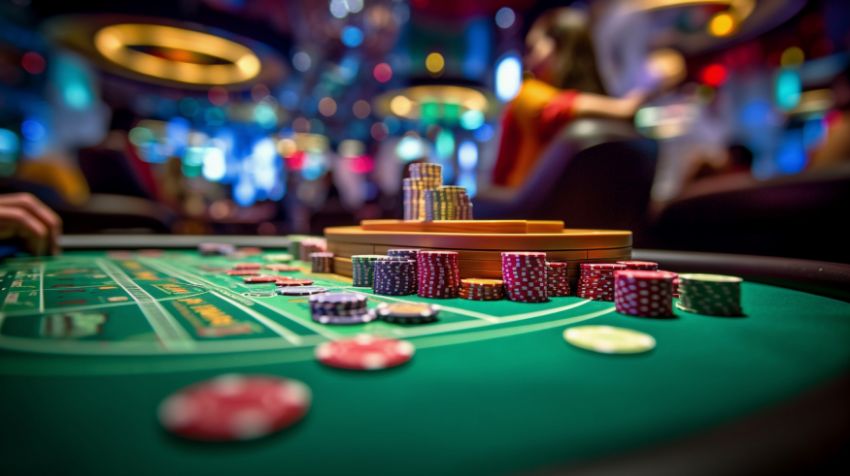Slot machine design incorporates psychological principles to maximize player engagement and retention.
The visual elements, including bright colors, dynamic graphics, and thematic designs, are strategically implemented to attract attention.
Auditory cues, such as celebratory sounds and music, further enhance the sensory experience.
A key psychological mechanism employed in slot machines is the variable-ratio reinforcement schedule.
This principle, derived from behavioral psychology, involves providing rewards at unpredictable intervals.
This unpredictability maintains player interest and motivation, as the possibility of a reward remains constant.
Near-miss experiences, where the outcome is close to a win, are deliberately programmed into slot machines.
Research has shown that these near-misses activate similar brain regions as actual wins, encouraging continued play despite losses.
Emotional triggers are another significant factor in slot machine design.
Machines often incorporate familiar themes, characters, or cultural references to create a sense of comfort or nostalgia.
This emotional connection can lead to increased time and money spent on the machine.
Understanding these design elements and psychological tactics can inform more conscious decision-making when interacting with slot machines.
It is important to recognize that these features are intentionally crafted to prolong play and potentially increase casino profits, rather than to benefit the player.
The Role of Colors
Colors serve a significant purpose in slot machine design, influencing player engagement and emotional responses.
Casino environments utilize vibrant hues to attract attention. Designers employ bright, warm colors such as red, yellow, and orange to stimulate excitement and create a sense of urgency. These colors have been shown to increase enthusiasm and risk-taking behavior in some individuals.
Conversely, cooler colors like blue and green are incorporated to promote a calming effect. This balance aims to create an inviting atmosphere that encourages prolonged player engagement.
The use of colors in casino design is based on established psychological principles that impact mood and behavior.
Winning combinations and jackpots are often highlighted with bright, flashing colors. This visual feedback is designed to reinforce positive associations with gameplay.
Background colors on slot machines are selected to minimize eye strain, potentially increasing player comfort during extended sessions.
The strategic application of color in slot machine design is a deliberate process aimed at optimizing the gaming experience. Understanding these color-based design principles provides insight into the psychological tactics employed in casino environments.
It’s important to note that while these design elements may influence behavior, individual responses can vary, and responsible gambling practices should always be observed.
Sound Effects and Music
Sound effects and music are significant components in the design of slot machines, contributing to player engagement and overall experience.
The auditory elements, including coin jingles, jackpot melodies, and reel spinning sounds, are carefully engineered to elicit emotional responses from players. These acoustic cues aim to create a sense of excitement and anticipation, potentially encouraging continued play.
The auditory environment of slot machines typically consists of several elements:
- Reel spinning sounds
- Background music
- Win celebrations
- Ambient casino noises
Research has shown that these sounds can influence player behavior and perception.
For example, studies have indicated that upbeat, fast-paced music may increase arousal levels and potentially lead to more rapid betting. Conversely, softer, more relaxing tunes might promote longer playing sessions by creating a comfortable atmosphere.
The use of sound in slot machines is rooted in principles of behavioral psychology.
Specifically, these auditory cues are designed to activate the brain’s reward system, potentially reinforcing playing behavior. The strategic placement of sounds throughout the gaming experience serves to maintain player attention and engagement.
It is important to note that while these sound effects and music can enhance the gaming experience, they also play a role in the addictive potential of slot machines.
Players should be aware of how these auditory elements may influence their behavior and decision-making processes while gambling.
Visual and Graphic Design
Visual and graphic design are integral components in slot machine development, serving both aesthetic and functional purposes.
The initial visual impact of a slot machine is often characterized by vivid colors and complex graphics, designed to attract potential players. This approach leverages human psychology, as bright colors and dynamic visuals tend to draw attention.
Thematic elements in slot machine design frequently incorporate popular cultural references or widely appealing concepts, such as historical periods, adventure motifs, or licensed entertainment properties.
This strategy aims to create familiarity and engagement with the player. High-resolution graphics and fluid animations contribute to a more polished and immersive gaming experience.
The design of symbols within slot games is crucial for user comprehension and engagement. Clearly defined, visually distinct symbols facilitate easier understanding of game mechanics.
When winning combinations occur, they’re typically emphasized through prominent visual effects. This immediate feedback mechanism serves to reinforce positive player experiences and potentially encourage continued play.
It is important to note that while these design elements can enhance the gaming experience, they also play a role in the addictive nature of slot machines.
The visual stimuli are carefully crafted to maintain player interest and potentially increase time spent on the machine. This aspect of slot machine design has been a subject of concern for those studying gambling addiction and responsible gaming practices.
Reward Systems
Reward systems in slot machines are designed to maintain player engagement and motivation.
These systems operate on a variable-ratio reinforcement schedule, which delivers rewards at unpredictable intervals. This unpredictability activates the brain’s reward centers, creating anticipation with each spin.
The machines incorporate frequent small payouts as a key component of their reward structure.
These minor wins provide intermittent reinforcement, encouraging continued play even in the absence of large jackpots.
Research in behavioral psychology has demonstrated that such intermittent rewards can be highly effective in sustaining repetitive behaviors.
Slot machines utilize multisensory feedback to enhance the reward experience.
When a win occurs, regardless of its size, the machine typically produces a combination of visual, auditory, and sometimes tactile stimuli.
Studies have shown that this sensory feedback can increase the perceived value of the reward and strengthen the association between the action (playing) and the outcome (winning).
The overall design of slot machine reward systems is based on established principles of operant conditioning and cognitive psychology.
These mechanisms work together to create an environment that encourages prolonged play and repeated visits.
While effective for casinos, it’s important to note that these systems can potentially contribute to problematic gambling behaviors in susceptible individuals.
Near Miss Phenomenon
The near miss phenomenon is a significant factor in slot machine design, contributing to player retention. This psychological effect occurs when symbols nearly align for a win but fall short.
It creates a cognitive response that encourages continued play, despite the absence of actual wins.
Slot machine manufacturers intentionally program their devices to produce these near misses, capitalizing on human psychology. The brain often interprets near misses as indicators of impending success, potentially triggering dopamine release similar to that associated with genuine rewards.
This neurochemical response can foster optimism about future outcomes.
The phenomenon exploits the human tendency to seek patterns in random events. Players may develop a false sense of skill or strategy, leading to an illusion of control over game outcomes.
This misperception can result in extended play sessions and increased expenditure.
Research suggests that near misses can be as stimulating as wins in terms of player engagement. However, it’s crucial to note that slot machine outcomes are governed by random number generators, and past results don’t influence future spins.
The frequency of near misses is carefully calibrated to maintain player interest without violating gaming regulations.
Understanding the near miss phenomenon is essential for responsible gambling practices and informed decision-making in casino environments.
It highlights the importance of recognizing cognitive biases that can influence gambling behavior.
Randomness and Payouts
Randomness and payouts are fundamental concepts in slot machine operation.
Slot machines employ Random Number Generators (RNGs) to ensure the unpredictability of each spin. These RNGs continuously generate numbers, regardless of whether the machine is in use, guaranteeing the independence of each outcome from previous or subsequent spins.
Payout mechanisms in slot machines are governed by a predetermined Return to Player (RTP) percentage.
This figure represents the average amount returned to players over an extended period. For example, a 95% RTP indicates that, theoretically, $95 is returned for every $100 wagered. It’s important to note that this is a long-term average, and short-term results can deviate significantly.
The use of RNGs and predetermined RTPs effectively eliminates any element of skill or strategy in slot machine play.
Each spin is an isolated event with its own probability of success, independent of past or future outcomes. This randomness ensures that winning on a slot machine is entirely based on chance, with no external factors capable of influencing the results.
Understanding these principles provides insight into the mechanics of slot machines and helps to dispel common misconceptions about their operation.
It also underscores the importance of responsible gambling practices, as the inherent randomness of these machines precludes any reliable method of predicting or influencing outcomes.
Player Engagement Tactics
Slot machine design incorporates various strategies to maintain player engagement.
Visual elements, such as vibrant graphics and animations, serve to attract initial attention. Audio components, including sound effects and background music, contribute to the overall sensory experience.
Game mechanics play a crucial role in sustaining player interest. Near-miss outcomes, where symbols align close to winning combinations, create a sense of anticipation and encourage continued play.
This psychological effect is intentionally integrated into machine algorithms.
Modern slot machines often feature recognizable themes from popular culture, such as movies, television shows, or video games. This familiarity can increase player comfort and connection with the game.
Bonus rounds and mini-games provide variety and additional opportunities for rewards, potentially extending play sessions.
Some machines incorporate social elements, allowing players to compete or share results.
This feature aims to enhance the gaming experience and potentially increase time spent on the machine.
It is important to note that while these design elements are intended to increase engagement, they don’t alter the fundamental randomness of slot machine outcomes or improve a player’s chances of winning.
Responsible gambling practices and awareness of these engagement tactics are advisable for players.
Emotional Triggers
Emotional triggers are a significant factor in slot machine design, influencing player engagement through psychological mechanisms. The design elements of slot machines incorporate various sensory stimuli, including visual and auditory cues, to create an immersive environment.
These elements are strategically implemented to elicit specific emotional responses from players.
One key aspect of slot machine design is the use of reinforcement schedules. Intermittent reinforcement, where rewards are given at unpredictable intervals, has been shown to be particularly effective in maintaining player engagement.
This principle is applied through variable reward systems, which can lead to prolonged play sessions.
Near-miss experiences are another psychological tool employed in slot machine design. These occur when the outcome appears close to a significant win, potentially encouraging continued play.
Research has indicated that near-misses can activate reward-related neural circuitry, similar to actual wins, despite the absence of a monetary reward.
Thematic elements in slot machines serve to increase player interest and relatability. By incorporating familiar themes or narratives, designers aim to create a more personalized experience for players.
This approach may enhance emotional investment in the game.
It is important to note that while these design elements can increase engagement, they also raise ethical concerns regarding their potential to contribute to problematic gambling behaviors.
Regulatory bodies in various jurisdictions have implemented measures to address these concerns, such as mandating the display of odds or limiting certain design features.
Conclusion
You’ve now got a peek into the intricate psychology behind slot machine design. From enticing colors and catchy sounds to strategic reward systems and emotional triggers, every element is crafted to keep you engaged. Recognizing these tactics helps you make informed decisions and gamble responsibly. Next time you’re at a casino, you’ll see through the flashing lights and ringing bells, understanding the true mechanics at play. Stay savvy and always play with awareness.

